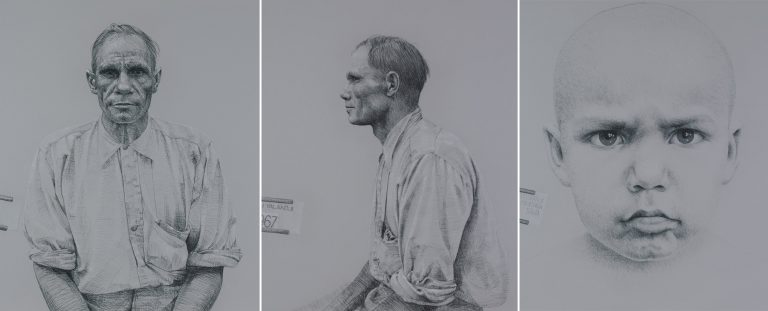We acknowledge the Traditional Owners of the land on which the Queensland Art Gallery | Gallery of Modern Art stands and recognise the creative contribution First Australians make to the art and culture of this country.

Vernon Ah Kee / Kuku Yalanji/Yidinyji/Guugu Yimithirr/Waanyi people / Australia b.1967 / Neither pride nor courage 2006 / Charcoal, crayon and synthetic polymer paint on canvas / Triptych: 174 x 240cm (each panel) / The James C Sourris, AM, Collection. Gift of James C Sourris through the Queensland Art Gallery Foundation 2007. Donated through the Australian Government’s Cultural Gifts Program / Collection: Queensland Art Gallery | Gallery of Modern Art / © Vernon Ah Kee
Vernon Ah KeeNeither pride nor courage 2006
Not Currently on Display
Neither pride nor courage 2006 is a triptych of drawings belonging to a series of large-scale hand-drawn portraits that Vernon Ah Kee has been developing since 2004. The portraits have predominately depicted male family members, with each relative’s portrait featuring a fixed gaze directly engaging the viewer. Two of the three panels making up this work present an image of Ah Kee’s grandfather, including this frontal view, and a second profile view.
This mode of representation reflects the practices of anthropologist Norman B Tindale (1900–93), who recorded vast amounts of genealogical information about Indigenous communities from all over Australia, the majority being collected from field trips conducted in the 1920s and 1930s.1 In these works, Ah Kee includes the glass slide labels of historical records indicating the subject’s language group and area; museums often provide these photographs to family members with the scientific information removed.
In the final image in the triptych, Ah Kee includes a portrait of his young son to assert a continued Aboriginal presence as a rejection of the nineteenth- and early twentieth-century idea that Indigenous people were destined to die out due to mistaken concepts derived from evolutionary theories.
Endnotes:
1 See https://www.slq.qld.gov.au/discover/past-exhibitions/transforming-tindale/gallery, accessed April 2020.
Vernon Ah Kee is a Brisbane-based artist at the forefront of conceptual art practice in Australia. He was born in Innisfail and is a descendant of the Kuku Yalanji, Yidinyji and Guugu Yimithirr people of north Queensland. He also has kinship connections to the Waanyi people of north-west Queensland.
Ah Kee developed an interest in art when his family moved to Cairns during his high school years. He studied at the Cairns College of TAFE before moving to Brisbane in 1990. He completed a Bachelor of Visual Arts (with Honours) in 2000 and a Doctorate of Visual Arts in 2007 at Griffith University’s Queensland College of Art. He is a founding member of the Aboriginal Artist collective proppaNOW, and in 2009 he represented Australia at the Venice Biennale.
Vernon Ah Kee is attuned to the politics of representation, and the social and economic implications of unequal cultural exchange in Australia. He often draws on ethnographic archives to challenge colonial legacies and to engage audiences with the strong and continuing presence of Aboriginal Australians, their histories and their cultures.
Discussion Questions
1. Like many contemporary artists, Vernon Ah Kee is interested in the politics of representation. How does the depiction of this Aboriginal man — as an anthropological or ethnographic study — influence our interpretation of the work?
2. What issues does the work raise in terms of the treatment of Aboriginal people?
3. Discuss the concept of marginalisation. Are there any people in your family, school or community who you think may feel they are marginalised? Why do you think these people feel this way?
Classroom Activities
1. Create a self-portrait and use a scanner or a photocopier to make several copies. Explore the ways in which your portrait can be manipulated to suggest a range of stereotyped representations — for example, an anthropological study, a celebrity photograph or a criminal mug shot.
2. Research the work of other Indigenous artists who address similar issues around representation in their work.